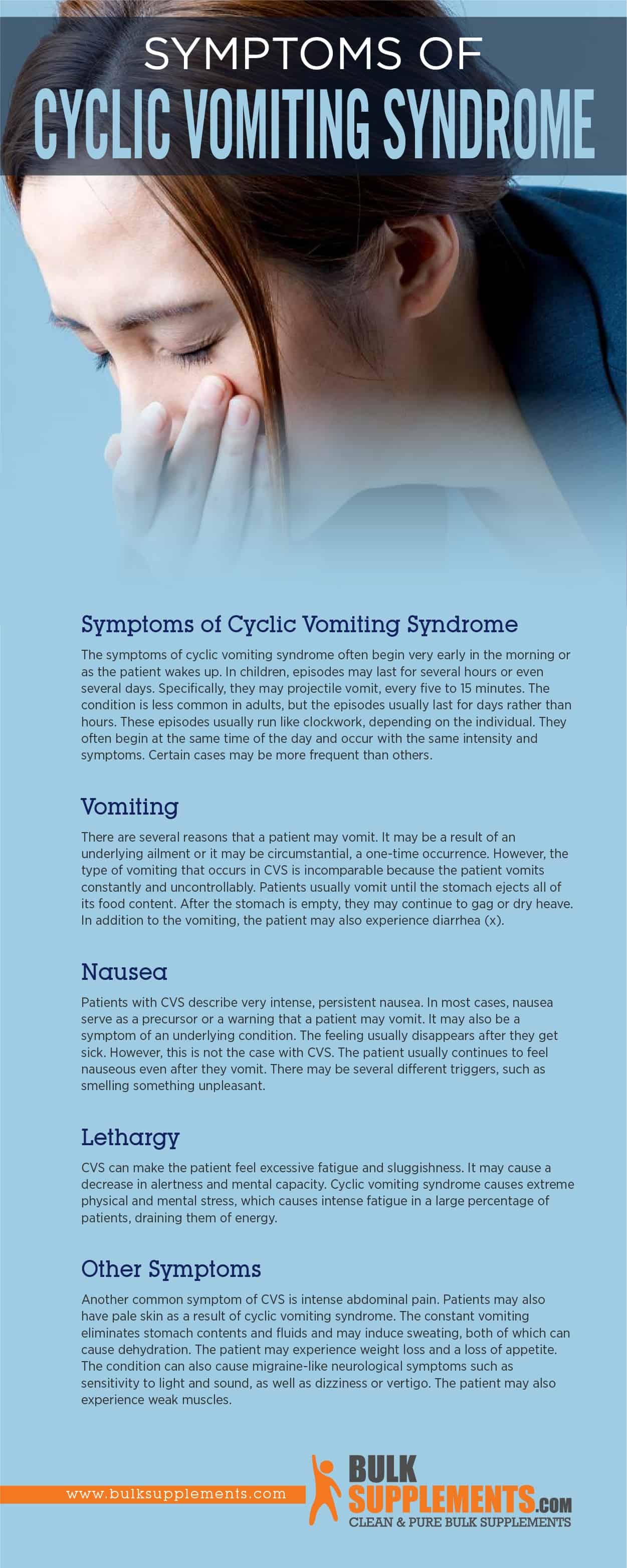Cyclic Vomiting Syndrome (CVS): Symptoms, Risk Factors & Treatment

Cyclic Vomiting Syndrome
What is Cyclic Vomiting Syndrome?
Cyclic vomiting syndrome (CVS) is a highly debilitating disorder that mainly occurs in young children. Patients with this syndrome experience consistent, constant and recurrent episodes of nausea, vomiting and physical exhaustion. The episodes may extend from about an hour to as long as 10 days. Affected individuals may vomit several times within a single hour. This results in a case of rapid dehydration. The symptoms—nausea, vomiting and lethargy—may occur either randomly or regularly based on a number of factors that may trigger the episodes. One common trigger is stress. Fasting, food allergies, menstruation, consuming certain foods or a lack of sleep may also trigger the condition.
Physicians also consider CVS a migraine variant. Migraines are severe headaches often accompanied by vomiting, pain, nausea and extreme sensitivity to light and sound. Similarly, the symptoms of cyclic vomiting syndrome are nearly identical to those of abdominal migraine, which is mainly characterized by severe cramping and bouts of intense stomach pain. Statistics suggest that a high percentage of patients with CVS or abdominal migraines have a family history of migraines. However, studies show that as the affected individual grows older, migraine headaches may replace the cyclic vomiting syndrome symptoms that they experienced as a child, if they are not already present. These attacks can be crippling and the condition may easily affect a patient’s entire life, preventing them from carrying out normal daily activities.
Symptoms of Cyclic Vomiting Syndrome
The symptoms of cyclic vomiting syndrome often begin very early in the morning or as the patient wakes up. In children, episodes may last for several hours or even several days. Specifically, they may projectile vomit, every five to 15 minutes. The condition is less common in adults, but the episodes usually last for days rather than hours. These episodes usually run like clockwork, depending on the individual. They often begin at the same time of the day and occur with the same intensity and symptoms. Certain cases may be more frequent than others.
Vomiting
There are several reasons that a patient may vomit. It may be a result of an underlying ailment or it may be circumstantial, a one-time occurrence. However, the type of vomiting that occurs in CVS is incomparable because the patient vomits constantly and uncontrollably. Patients usually vomit until the stomach ejects all of its food content. After the stomach is empty, they may continue to gag or dry heave. In addition to the vomiting, the patient may also experience diarrhea.
Nausea
Patients with CVS describe very intense, persistent nausea. In most cases, nausea serve as a precursor or a warning that a patient may vomit. It may also be a symptom of an underlying condition. The feeling usually disappears after they get sick. However, this is not the case with CVS. The patient usually continues to feel nauseous even after they vomit. There may be several different triggers, such as smelling something unpleasant.
Lethargy
CVS can make the patient feel excessive fatigue and sluggishness. It may cause a decrease in alertness and mental capacity. Cyclic vomiting syndrome causes extreme physical and mental stress, which causes intense fatigue in a large percentage of patients, draining them of energy.
Other Symptoms
Another common symptom of CVS is intense abdominal pain. Patients may also have pale skin as a result of cyclic vomiting syndrome. The constant vomiting eliminates stomach contents and fluids and may induce sweating, both of which can cause dehydration. The patient may experience weight loss and a loss of appetite. The condition can also cause migraine-like neurological symptoms such as sensitivity to light and sound, as well as dizziness or vertigo. The patient may also experience weak muscles.

Risk Factors for Cyclic Vomiting Syndrome
Physicians have not identified a specific cause for CVS. However, there are several risk factors that may increase the risk. Even though vomiting and nausea are gastrointestinal symptoms, physicians believe the condition stems from the brain. Research suggests that abnormalities in the brain can interfere with its connection to the digestive system.
Stress
The body expresses different reactions to stress. An extremely overactive reaction may trigger episodes of CVS. The body may release large amounts of a hormone called corticotropin-releasing factor (CRF) from the hypothalamus, stimulating the adrenal cortex. The adrenal cortex is the outer part of the adrenal glands that controls how the body responds to stress. Statistics show that patients who experience cyclic vomiting syndrome have very high-stress levels that may trigger the symptoms.
Anxiety and Depression
Patients with CVS often also suffer from other related psychological comorbidities, such as anxiety and depression. This also relates to how the patient processes stress and the stress hormone activity in the body.
Migraine
Some physicians consider cyclic vomiting syndrome as a migraine variant because according to research, there is a strong connection between the two. A considerable amount of patients with CVS also have migraines or the condition may run in the family. A migraine is a severe headache that causes nausea or vomiting. Physicians call CVS an abdominal migraine because both conditions cause severe, recurring attacks. If a patient has CVS as a child, the symptoms usually subside as they get older, but they may start to experience migraines instead if they do not experience them already.
Other Risk Factors
Autonomic disturbances may surface between episodes, including fainting or reflex sympathetic dystrophy, a chronic pain condition. More frequently, the patient experiences other gastrointestinal symptoms, including gastroesophageal reflux (GERD), irritable bowels, constipation or delayed gastric emptying that causes bloating.
Research also connects CVS to autistic spectrum disorders, attention deficit hyperactivity disorder (ADHD) and seizures. If a patient has CVS along with these developmental conditions, researchers refer to it as cyclic vomiting syndrome plus.
Treatment for Cyclic Vomiting Syndrome
Treating cyclic vomiting syndrome mainly aims to treat the symptoms that accompany it because of how severe the condition can be. To diagnose the condition, the physician assesses the patient’s history and performs a blood and urine test, as well as an X-ray to rule out other conditions that may trigger cyclic vomiting. Then the physician will come up with a plan to help the patient manage the condition.
Medical Treatment
Cyclic vomiting syndrome has no definite cure. But physicians aim to help manage the unpleasant symptoms. Doctors might prescribe medications for a number of drugs including anti-nausea drugs, pain relieving medications or anti-migraine pills if the patient has a history of migraines. Patients may stop or prevent CVS episodes with drugs that aim to treat migraines.
Also, researchers are studying whether anti-seizure and anti-vomiting medications may help. A doctor may administer fluids through an IV to rehydrate the patient. Treatment depends on the individual and not every treatment will successfully reduce every patient’s symptoms. It may take time to find the right treatment method.
SEE ALSO

Emphysema: Symptoms, Causes & Treatment
Diet
Although it will not cure the condition, making different lifestyle changes may help manage symptoms and recover after a cyclical vomiting episode. Sometimes the condition results from food allergies, so identifying certain foods that trigger it can help prevent recurring nausea and vomiting.
When a patient experiences a CVS episode, it’s important to rehydrate and redistribute nutrients throughout the body. Do not skip meals between episodes. After an episode, it is a good idea to consume clear liquids and gradually return to a normal, well-balanced diet. Choose drinks with glucose and electrolytes to rehydrate, including fruit juices, sports drinks or broths. To prevent a recurrence, avoid foods that have triggered past episodes. Some patients react to chocolate, cheese, alcohol or foods with monosodium glutamate. Patients can consult with a doctor for dietary suggestions. Physicians may also recommend supplements to encourage digestive health, manage migraines and help patients recover from CVS episodes.
Supplements for Cyclic Vomiting Syndrome
Coenzyme Q10 (COQ10)
Also called ubiquinone, Coenzyme Q10 is an antioxidant that helps make sure that the body’s cells function properly. It also helps to eliminate free radicals and regulate metabolic processes in the body. It may be an effective supplement for CVS because it also helps manage migraines. According to research, subjects experienced a decrease in migraines with 100 mg of COQ10 three times a day for three months. Even though the body produces it naturally, supplements may be a good way to get a consistent dosage. As a supplement, take 50 to 200 mg of Coenzyme Q10 powder once a day. Discuss dosages with a physician before starting or changing a supplement regimen.
L-Carnitine
The body produces L-carnitine naturally as well. It helps the body convert fat into energy, which patients suffering from CVS may require. Studies claim that it is an effective management tool for CVS to prevent vomiting episodes, especially in combination with COQ10. Supplements can help patients control their dietary intake. For supplemental use, take Acetyl L-carnitine in 600 mg doses up to three times a day.
Riboflavin
The body does not produce riboflavin (Vitamin B2) in the body naturally. It is one of the major B vitamins, which helps regulate mitochondrial processes and energy metabolism. According to studies, riboflavin may be an effective treatment for cyclic vomiting syndrome. Although the body does not produce Vitamin B2 naturally, it is available as a supplement. As a dietary supplement, take 50 mg of riboflavin (Vitamin B2) powder once or twice a day. Confirm dosage with a doctor before taking the supplement.
The Bottom Line
Cyclic vomiting syndrome is an exhausting condition that causes constant, recurring episodes of vomiting, nausea, intense stomach pain and extreme fatigue. It is most common in children, but adults may experience the condition as well with longer episodes. Researchers consider it a migraine variant because nausea and vomiting are also symptoms of migraine headaches.
Researchers believe that the condition is the result of an interference between brain and digestive system communication. There is no specific cause, but there are a variety of risk factors, such as stress, anxiety and depression. Researchers also associate it with developmental or learning disorders, such as ADHD or autistic spectrum disorders.
There is no specific cure for CVS, but there are different treatment options that aim to address and manage the symptoms, including pain or anti-migraine medications. Antidepressants, anti-vomiting and anti-seizures may help as well and researchers are conducting studies on their efficacy. There are also dietary changes a patient can make to help manage or prevent the symptoms, including identifying food allergies and consuming electrolytes to rehydrate after a vomiting episode. Supplements like Coenzyme Q10, L-carnitine and riboflavin (Vitamin B2) may also help those suffering from CVS, but they are not a proper medical treatment. Always consult a doctor to discuss how supplements may benefit your health before you start a regimen.



